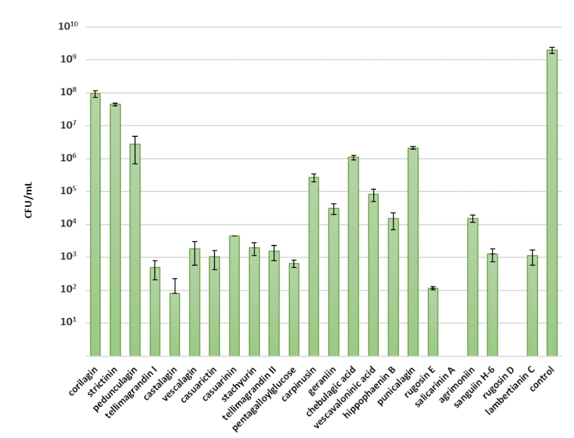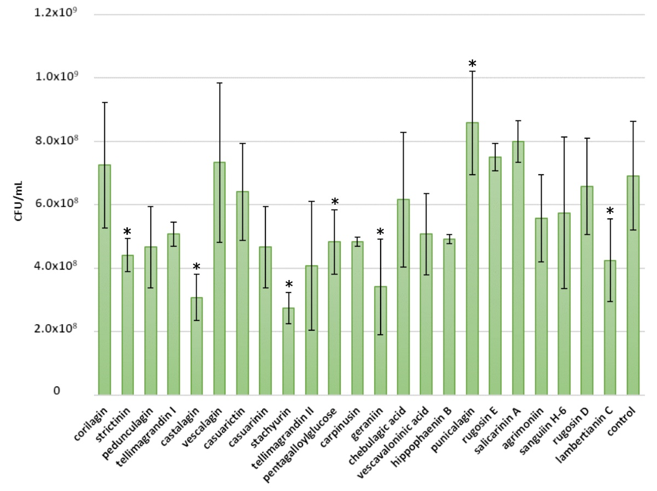The growth inhibition effect of 22 individual ellagitannins and of pentagalloylglucose was tested on four bacterial species: Clostridiales perfringens, Escherichia coli, Lactobacillus plantarum and Staphylococcus aureus
Recently, we published a paper looking at the antimicrobial activities of ellagitannins and found ellagitannins to be potent and promising antimicrobials:
Ellagitannins showed antimicrobial effect against S. aureus, E. coli and C. perfringens
The level of inhibition was the greatest for S. aureus (Figure 1) and the weakest for C. perfringens. For S. aureus, the molecular size or flexibility of ellagitannins did not show a clear relationship with their antimicrobial activity, even though rugosins E and D and pentagalloylglucose with four or five free galloyl groups had a stronger growth inhibition effect than the other ellagitannins with glucopyranose cores but with less free galloyl groups. For S. aureus, the oligomeric linkage of ellagitannin might have an effect on its antimicrobial activity. For E. coli, the molecular size, but not the molecular flexibility, of ellagitannins seemed to be an important factor, and for C. perfringens, both the molecular size and the flexibility of ellagitannin were important factors.

Figure 1. Growth of Staphylococcus aureus (expressed as number of colony-forming units (CFU) per mL) following a 24 h treatment with 0.5 mM ellagitannin and pentagalloylglucose solutions. p < 0.05 for all compounds.
Ellagitannins showed no or very weak growth inhibition for L. plantarum
No or very weak growth inhibition was detected for L. plantarum, as a growth corresponding to 108 CFU/mL was observed both in the positive control and after the addition of a 0.5mM tannin solution (Figure 2). However, even though the growth in the control seemed always to be higher, based on a paired t-test, strictinin, castalagin, stachyurin, pentagalloylglucose, geraniin, punicalagin and lambertianin C showed a minor inhibition against L. plantarum. The lack of growth inhibition is was a desired result as Lactobacillus comprises many probiotic species.

Figure 2. Growth of Lactobacillus plantarum (expressed as number of colony-forming units (CFU) per mL) following a 24 h treatment with 0.5 mM ellagitannin and pentagalloylglucose solutions. * p < 0.05.
Acknowledgements
The research project was multidisciplinary and it was carried out in collaboration with professor Martin J. Woodward and PhD Gemma Walton from University of Reading, UK. This research was funded by the Academy of Finland, grant number 310549 to Maarit Karonen.
© 2020 by the authors. Licensee MDPI, Basel, Switzerland. This article is an open access article distributed under the terms and conditions of the Creative Commons Attribution (CC BY) license (http://creativecommons.org/licenses/by/4.0/).
